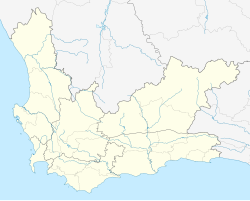
Back Wellington, Wes-Kaap Afrikaans ويلينغتون (جنوب أفريقيا) Arabic ويلينجتون (دراكينستين لوكال مونيسيپاليتى) ARZ Wellington (Südafrika) German Velingtono (Sud-Afriko) Esperanto Wellington (LAV) Estonian Wellington (Afrique du Sud) French Wellington (Sudafrica) Italian ウェリントン (南アフリカ) Japanese Wellington Malagasy
Wellington | |
|---|---|
From top, Wellington CBD, with the NG Mother Church and snowy Wemmershoek Peak beyond. Dutch Reformed Church Complex in Wellington (centre left). Lady Loch Bridge over the Berg River (centre right). Coronation Arch in Victoria Jubilee Park (bottom left). Second Boer War block house (bottom right). | |
| Motto(s): Par Foi et Loyaute (French: By faith and loyalty) | |
| Coordinates: 33°38′S 18°59′E / 33.633°S 18.983°E | |
| Country | South Africa |
| Province | Western Cape |
| District | Cape Winelands |
| Municipality | Drakenstein |
| First settled by Europeans | 1685 |
| Established | 1840[1] |
| Area | |
• Total | 30.16 km2 (11.64 sq mi) |
| Population (2011)[2] | |
• Total | 55,543 |
| • Density | 1,800/km2 (4,800/sq mi) |
| Racial makeup (2011) | |
| • Black African | 16.2% |
| • Coloured | 67.3% |
| • Indian/Asian | 0.4% |
| • White | 15.4% |
| • Other | 0.6% |
| First languages (2011) | |
| • Afrikaans | 81.2% |
| • Xhosa | 10.7% |
| • English | 5.9% |
| • Other | 2.1% |
| Time zone | UTC+2 (SAST) |
| Postal code (street) | 7655 |
| PO box | 7654 |
| Website | Wellington Tourism |
Wellington is a town in the Western Cape Winelands, a 45-minute drive from Cape Town, in South Africa with a population of approximately 62,000. Wellington's economy is centered on products of agriculture such as deciduous fruit, table grapes, wine and brandy. The town is located 75 km north-east of Cape Town, reached by the N1 motorway and R44. Due to the growth of the Vlakkeland and Mbekweni township south of the town, it now forms a de facto urban unit with Paarl, just 10 km to the south. Wellington now officially falls under the Drakenstein Local Municipality, which also covers Saron and Paarl.
- ^ Robson, Linda Gillian (2011). "Annexure A" (PDF). The Royal Engineers and settlement planning in the Cape Colony 1806–1872: Approach, methodology and impact (PhD thesis). University of Pretoria. pp. xlv–lii. hdl:2263/26503.
- ^ a b c d "Main Place Wellington". Census 2011.







